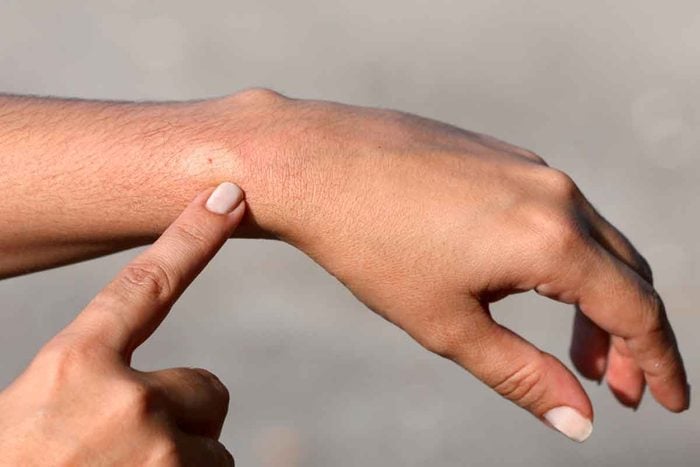What to Do When a Wasp Stings You

If you spend time outside, you’ll likely encounter wasps. In the event that you get stung, this is what you need to know.
Summer time is great for being outdoors and enjoying some sunshine. But that’s also when wasps, and other annoying pests, are out and about.
On This Page
Do Wasps Sting or Bite?
Wasps, like almost any creature, can bite. But their tiny jaws aren’t what they are known for. It’s their sting that most people fear.
Unlike bees, whose stingers remain embedded in the skin, wasps keep their stingers after an attack, so they can sting more than once. That’s one of the main differences between wasps and bees. Wasps also tend to be more aggressive. Although many people would prefer to keep both wasps and bees out of their yards, some maintain backyard bee hives, and wasps can attack those domestic colonies when scavenging for food.
Do Wasps Die When They Sting You?
No, wasps do not die after they sting. Bee stingers — excluding bumblebees — have a large barb that causes it to tear from the body after use, resulting in the bee’s death.
According to the Washington State Department of Health, wasps have smaller barbs which do not stick in their target. Even if a wasp stings multiple times, it will retain its stinger. So if you’re wondering what to do when a wasp stings you, start by leaving it alone so that it doesn’t strike again.
Wasp Sting Symptoms
Reactions to wasp venom varies from person to person. Some will only have minor pain and redness. Others may have severe allergic reactions.
Typical wasp sting symptoms include sharp pain at the sting site, redness and a raised welt with a small, white mark at the center. These mild reactions should subside after a few hours. More severe symptoms may include redness or swelling that persists or worsens for several days, nausea and vomiting.
If you or someone near you is stung by a wasp, be sure to monitor for symptoms of an allergic reaction. Swollen facial features or a swollen throat, hives or itching away from the sting itself, and trouble breathing are a few symptoms that can signal a life-threatening allergy. Check for Healthline’s signs of anaphylaxis and seek medical attention when necessary.
What to Do When a Wasp Stings You (How to Treat a Wasp Sting)
Wasp sting treatment depends on the reaction you have. For most, a wasp sting does not require medical intervention. If you only experience the typical symptoms, wash the sting site with soap and water and treat swelling with a cold compress or ice. You may also consider using an anti-itch cream, over the counter pain reliever, antihistamine or natural bug bite remedy to counteract any pain or itching.
However, if you experience more severe symptoms such as vomiting, hives or a constricted airway, it’s best to seek immediate medical attention. Professional wasp sting treatment is needed in case of a life-threatening allergy.
Wasp Prevention
If you’ve been stung, chances are that you’ll want to prevent it from happening again. When you encounter wasps at a park or other public area, there isn’t much you can do about them. But there are some steps you can take to deter wasps from your home.
The first step is finding out if you have a nest near your living space. You can try spraying the wasp nest yourself or hire a pest control professional. Smaller preventative steps recommended by the Centers for Disease Control and Prevention include avoiding perfumed soaps and toiletries, cleaning up discarded food, wearing clothing that covers your body and refraining from swatting at wasps. While these steps will not get rid of stinging pests, they may stop wasps from seeing you as a target.


